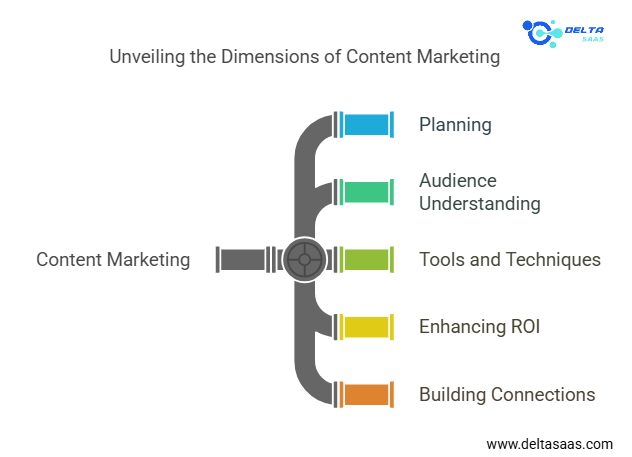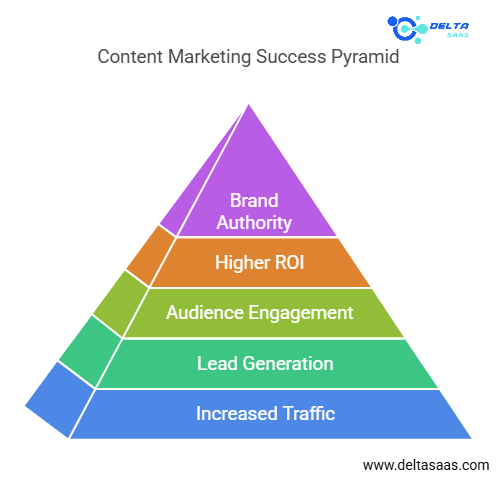
Content Marketing Tips: A Comprehensive Guide
Content marketing has become a cornerstone of successful digital strategies for businesses across industries. Whether you’re a small business, a B2B company, or a digital marketing agency, effectively leveraging content can drive traffic, generate leads, and boost conversions. But crafting a winning content marketing strategy requires more than just creating blog posts—it involves precise planning, audience understanding, and various tools and techniques.
This guide explores essential content marketing tips to help you improve your campaigns, enhance ROI, and build meaningful connections with your audience.
The Importance of Content Marketing
Content marketing is more than just publishing content—it’s about providing valuable, relevant, and engaging content that attracts and retains your audience. Companies like Rebuild Habitat have leveraged powerful storytelling to build brand loyalty, while small businesses can use content to stand out in niche markets.

Key Benefits of Content Marketing:
- Increased Traffic: Effective SEO and quality content drive organic visits to your website.
- Lead Generation: Capture leads by offering value, such as free guides or newsletters.
- Audience Engagement: Build relationships with your audience through blogs, social media, and email campaigns.
- Higher ROI: Content marketing is cost-effective compared to traditional advertising channels.
- Improved Brand Authority: Sharing insightful content establishes you as an expert.
If you’re looking for the best software, check out Delta SaaS, which offers discounts and lifetime deals on SaaS products.
Start With a Clear Content Marketing Strategy
A strong content marketing strategy acts as a roadmap for your efforts. It defines your goals, audience, and the types of content you’ll create to meet your objectives.

Steps to Create a Content Marketing Strategy:
- Set Clear Goals:
Define measurable goals, such as increasing website traffic by 30% or generating 50 monthly leads. Goals should align with your digital marketing plan and overall business objectives. - Know Your Audience:
Understand your audience’s pain points, preferences, and needs. Create buyer personas to represent your ideal customers. For instance, a financial advisor targeting millennials might focus on content about debt management or first-time investments. - Perform Competitor Analysis:
Research your competitors to identify gaps in their content and find opportunities to create something better. Tools like SEMrush or Ahrefs can help analyze competitor content performance. - Choose Content Types and Channels:
Decide whether to focus on blogs, infographics, videos, or email campaigns. Also, choose platforms like Instagram, LinkedIn, or YouTube based on where your audience spends time. - Create a Content Calendar:
Use a calendar to plan your content. Include publishing dates, topics, and formats to ensure consistency.
Example:
A real estate business could plan blog posts about home-buying tips, video walkthroughs for properties, and infographics on market trends to engage buyers and sellers.
Also Read,
Merlin Lifetime Deal – AI for Productivity Boost
OnlyPrompts Lifetime Deal – AI-Powered Prompt Generator
Paperguide Lifetime Deal – Writing Assistant Made Easy
Sinosend Lifetime Deal – Simplify International Shipping
Slay School Lifetime Deal – Learn Skills for Success
Socrates Lifetime Deal – AI for Knowledge Sharing
Focus on Creating Valuable Content
The foundation of any content marketing effort is value. Your audience should find your content helpful, actionable, or entertaining. With value, your efforts will be able to generate results.
Tips for Creating Effective Content:
- Answer Audience Questions:
Address common concerns or queries that your audience may have. Use tools like AnswerThePublic or Google’s “People Also Ask” section to find relevant topics. - Diversify Your Content:
Don’t rely solely on blog posts. Use a mix of formats such as:- Infographics for visually presenting data or processes.
- Videos for tutorials or customer stories.
- Email newsletters for personalized updates.
- Social media posts for quick and engaging updates.
- Leverage User-Generated Content (UGC):
Encourage your audience to share reviews, testimonials, or photos with your products. UGC builds trust and authenticity. - Use Templates for Efficiency:
Content templates help save time while maintaining quality. For example, a content calendar template ensures consistency in planning and publishing.
Optimize Content for SEO
SEO plays a critical role in driving traffic to your content. With proper optimization, even the best-written content may be noticed.
Key SEO Tips for Content Marketing:
- Conduct Keyword Research:
Use tools like Google Keyword Planner to identify relevant keywords. Then, naturally incorporate these into your headlines, meta descriptions, and body content. - Focus on Long-Tail Keywords:
Targeting long-tail keywords like “Strong Building Customer Relationships for Success” or “Brand Building Strategies” helps you rank higher for specific queries. - Create Engaging Headlines:
Write headlines that are clear, compelling, and optimized for search engines. Use numbers or actionable phrases like “Best Ways to Increase Traffic to Your Website with Proven Methods.” - Add Internal and External Links:
Link to related blog posts on your site and credible external sources to boost SEO and provide additional value to readers. - Optimize for Mobile:
Ensure your website and content are mobile-friendly, as over 50% of web traffic comes from mobile devices.
Example:
A B2B marketing agency might optimize a blog post titled “Top 5 Content Marketing Strategies for SaaS Companies” with relevant keywords, internal links to case studies, and external links to authoritative resources.
Use Visual Content to Enhance Engagement
In content marketing, visuals are powerful in capturing attention and improving comprehension. Research shows that people process visual information 60,000 times faster than text, making formats like infographics, videos, and diagrams essential to a successful strategy.
Why Visual Content Matters
- Boosts Engagement: Posts with visuals get more likes, shares, and comments on social media.
- Simplifies Complex Information: Charts and infographics make data easier to understand.
- Improves Retention: Readers are more likely to remember visual content than plain text.
Tips for Effective Visual Content
- Create Infographics:
Infographics are ideal for simplifying statistics, processes, or timelines. For example, a digital marketing funnel infographic can illustrate how leads move through the buyer journey. - Use High-Quality Images:
Avoid stock photos that look generic or overused. Opt for custom graphics or high-quality images relevant to your content. - Add Diagrams or Charts:
Use diagrams to break down complex ideas. For example, a content marketing matrix can show which formats work for each customer journey stage. - Incorporate Video Content:
Videos, whether tutorials or customer testimonials, are highly engaging. A real estate business, for instance, can showcase property tours via video for a more immersive experience. - Embed Visuals in Blogs:
Break up text-heavy blogs with visuals to make the content more digestible. Use images, videos, or even pyramids and flowcharts.
Example:
A small business blog might feature an infographic about “Tips for Boosting Online Sales Effectively” to capture attention and drive social shares.
Repurpose Your Content
Repurposing content allows you to extend the value of your existing work by adapting it for different formats or platforms. It saves time and maximizes the reach of your marketing efforts.
How to Repurpose Content
- Turn Blogs Into Social Posts:
Extract key points from a blog post and share them as bite-sized tips on Instagram or LinkedIn. To increase engagement, add a relevant image or graphic. - Convert Data Into Infographics:
Use research or statistics from reports or blog posts to create eye-catching infographics. - Make Videos From Blog Posts:
Summarize blog content into short explainer videos and share them on YouTube or social media platforms. - Compile Blogs Into E-Books:
Combine multiple related blog posts into a comprehensive e-book or whitepaper for lead generation. - Use Testimonials in Campaigns:
Feature customer success stories from past campaigns in email marketing or advertisements.
Promote Your Content Effectively
Creating high-quality content is just the beginning. To achieve results, you need to ensure your audience sees it. Effective promotion amplifies your reach and increases your content’s impact.
Content Promotion Tips
- Use Social Media:
Share content across platforms like Facebook, LinkedIn, and Instagram. Tailor each post to the platform. For example, keep Instagram captions concise but add hashtags to improve visibility. - Leverage Email Marketing:
Share new blog posts, infographics, or videos with your subscribers. To increase open rates, make sureyour email subject lines are eengaging - Boost Content With Paid Ads:
Use advertising on platforms like Google Ads or social media to target specific audiences. For instance, a B2B company can use LinkedIn ads to reach decision-makers. - Collaborate With Influencers:
Partner with industry influencers to share your content with their followers. For example, financial advisors can collaborate with finance bloggers to promote investing content. - Engage With Online Communities:
Share content on relevant forums, Facebook groups, or Reddit threads where your audience is active. Instead of self-promotion, engage in discussions to add value. - Update and Repost Old Content:
Refresh older, high-performing blog posts with updated data or new examples and reshare them on your channels.
Track Performance and ROI
Monitoring your efforts and measuring their success is essential to refine your content marketing strategy. Tracking metrics provides insights into what’s working and where you need to improve.
Key Metrics to Monitor
- Traffic and Page Views:
Measure how many visitors your content attracts to your website. - Engagement Rates:
Track likes, comments, shares, and time spent on your content. - Lead Generation:
Analyze how many leads your content generates through forms, gated content, or downloads. - Conversion Rates:
Measure how many leads or visitors turn into customers. - SEO Performance:
Tools like Google Analytics or SEMrush can be used to track keyword rankings and organic search traffic. - ROI:
Compare the revenue generated from your content marketing efforts with the costs of creating and promoting the content.
Example:
A small business using analytics tools could identify that their blog posts with infographics perform 40% better in traffic and lead generation, allowing them to prioritize visual content moving forward.
Advanced Content Marketing Tips to Maximize Results
Once you have the basics, adopt advanced techniques to take your content marketing strategy to the next level. These strategies help improve efficiency, increase ROI, and ensure your content stands out in a competitive landscape.
Conduct a Content Gap Analysis
A content gap analysis identifies topics your competitors cover that you’re not and areas where your audience’s needs are unmet. This process ensures that your content addresses all stages of the customer journey.
Steps for Content Gap Analysis:
- Audit Your Existing Content: Evaluate what you already have and identify underperforming pieces.
- Research Competitor Content: Use tools like Ahrefs or SEMrush to analyze competitor blogs, videos, and landing pages.
- Identify Missing Topics: Look for gaps in your current strategy. For example, you might lack middle-of-the-funnel (MOFU) content, like case studies or product comparisons.
- Create New Content: Address these gaps with fresh, high-value pieces.
Example: A real estate agency might discover the missing article “Why Is Effective Online Communication Important?” and create an infographic to simplify the process for first-time buyers.
Incorporate Storytelling Into Your Content
Storytelling creates emotional connections with your audience, making your content memorable and impactful. Brands like Rebuild Habitat use this strategy to focus on happiness and connection in their campaigns.
How to Use Storytelling:
- Make It Relatable: Share real-life success stories, customer testimonials, or behind-the-scenes moments.
- Highlight Your Mission: Explain why your business exists and how it solves customer problems.
- Engage With Your Persona: Align your storytelling with the preferences and emotions of your target audience.
Example: A financial advisor could share stories about how their guidance helped clients achieve financial freedom.
Build Content Hubs
A content hub is a centralized resource that organizes related pieces of content around a specific topic. It’s an excellent way to improve SEO and user experience.
Steps to Create a Content Hub:
- Choose a Core Topic: Identify a topic that interests your audience, such as “Improve online business.”
- Create Pillar Content: Write an in-depth blog post or guide covering the topic comprehensively.
- Link Cluster Content: Publish related blogs, infographics, and videos and link them to the pillar content.
For example, a digital marketing institute might create a content hub on “SEO Basics,” linking to articles about keyword research, link building, and on-page optimization.
Use Analytics to Improve Your Strategy
Monitoring content performance is crucial for optimizing your efforts. Analytics tools provide data on what resonates with your audience and where adjustments are needed.
Recommended Tools:
- Google Analytics: Track traffic, bounce rates, and conversions.
- SEMrush or Ahrefs: Analyze keyword rankings and backlink profiles.
- Social Media Insights: Platforms like Instagram and LinkedIn offer data on post engagement.
Actionable Insights:
- High-Performing Content: Repurpose or update top-performing pieces for maximum impact.
- Low-Performing Content: Rewrite or reformat underperforming content to improve its effectiveness.
Example: Testing different subject lines or segmenting the audience can improve its results if an email campaign has a low open rate.
Repurpose Content for Evergreen Value
Repurposing content isn’t just about efficiency—it also ensures your content remains relevant over time. Evergreen content provides long-lasting value and continuously attracts traffic.
Evergreen Content Ideas:
- How-To Guides: Timeless topics, like “How to be successful in digital marketing?” stay relevant for years.
- Checklists: These are useful for step-by-step tasks, such as “10 Steps to Optimize Your Website for SEO.”
- Templates: Share tools like cover letter templates, content calendars, or email marketing templates.
Example: A small business content strategy could include evergreen blog posts repurposed into video tutorials, social media graphics, and downloadable checklists.
Optimize Your Content for Different Stages of the Funnel
Content should address different stages of the buyer journey, from awareness to decision-making. Each piece of content should guide your audience one step closer to conversion.
Funnel-Based Content:
- Top-of-Funnel (TOFU): Create educational content like blogs or videos to build awareness.
- Middle-of-Funnel (MOFU): To generate interest, offer product comparisons, testimonials, or case studies.
- Bottom-of-Funnel (BOFU): Focus on conversion content, like free trials, demos, or pricing pages.
Example: To nurture leads, a B2B business could offer a free e-book at the TOFU stage, a case study at the MOFU stage, and a live demo at the BOFU stage.
Leverage Inbound Marketing
Inbound marketing focuses on attracting customers through valuable content rather than interruptive advertising. This strategy naturally integrates with content marketing and helps attract high-quality leads.
Inbound Marketing Tactics:
- Lead Magnets: Offer free resources, such as whitepapers or templates, in exchange for email addresses.
- Email Drip Campaigns: Nurture leads with emails that deliver valuable information over time.
- SEO Optimization: Create content optimized for search engines to increase organic traffic.
Example: A marketing institute might offer a free “Digital Marketing Basics” course to attract potential students, then use email campaigns to encourage enrollment.
Prioritize User Experience
A great user experience (UX) ensures visitors stay on your site longer and engage with your content. Poor UX, on the other hand, can lead to high bounce rates and lost opportunities.
Tips to Improve UX:
- Use Readable Fonts and Colors: Ensure your text is easily read on all devices.
- Make Navigation Simple: Create a straightforward menu and use internal links to guide users through your site.
- Optimize Load Times: Slow-loading pages frustrate users and hurt your SEO.
Example: A resume template website could improve UX by categorizing templates by industry and offering quick previews.
Publish Original Research
Creating and publishing original research positions your brand as a thought leader. It also generates backlinks, increasing your content’s authority and SEO performance.
Ideas for Original Research:
- Surveys: Conduct polls or surveys to collect industry data.
- Case Studies: Highlight successful campaigns or projects with measurable results.
- Trend Reports: Analyze market trends relevant to your industry.
For example, a financial advisor could publish a study about “Professional Home Remodeling” to attract attention and gain authority.
Conclusion
Effective content marketing is more than just writing blogs—it’s a strategic process that involves understanding your audience, creating high-value content, and promoting it effectively. By leveraging tools like infographics, repurposing existing content, optimizing for SEO, and focusing on the customer journey, you can drive traffic, generate leads, and increase conversions.
Consistency and creativity are key. Whether you’re a small business, a real estate agent, or a B2B marketer, applying these content marketing tips will help you achieve long-term success. Start building your strategy today and reap the benefits of a well-executed content marketing plan!
FAQs About Content Marketing Tips
What is content marketing?
Content marketing involves creating and sharing valuable content to attract, engage, and retain an audience and drive profitable actions.
What are the 4 pillars of content marketing?
The four pillars are audience understanding, consistent content creation, strategic distribution, and performance measurement.
How do I create a content marketing plan?
Set clear goals, research your audience, choose content types and channels, develop a calendar, and measure performance.
What are some practical content marketing ideas for small businesses?
Create how-to guides, share customer testimonials, use infographics, and leverage social media for engagement.
Why is SEO important in content marketing?
SEO ensures your content ranks higher in search results, driving more organic traffic to your website.
How can I measure the ROI of content marketing?
Track metrics like traffic, leads, conversions, and customer lifetime value compared to content creation costs.
What types of content work best for social media?
Short videos, infographics, quotes, and user-generated content perform well on platforms like Instagram and LinkedIn.
What tools can help with content marketing?
Tools like SEMrush, Google Analytics, Canva, HubSpot, and Buffer can streamline content creation, SEO, and promotion.
How can I make my content stand out?
Focus on storytelling, use compelling visuals, and publish original research to differentiate your content.
What is a content hub?
A content hub organizes related content around a central topic, improving SEO and providing value to readers.


